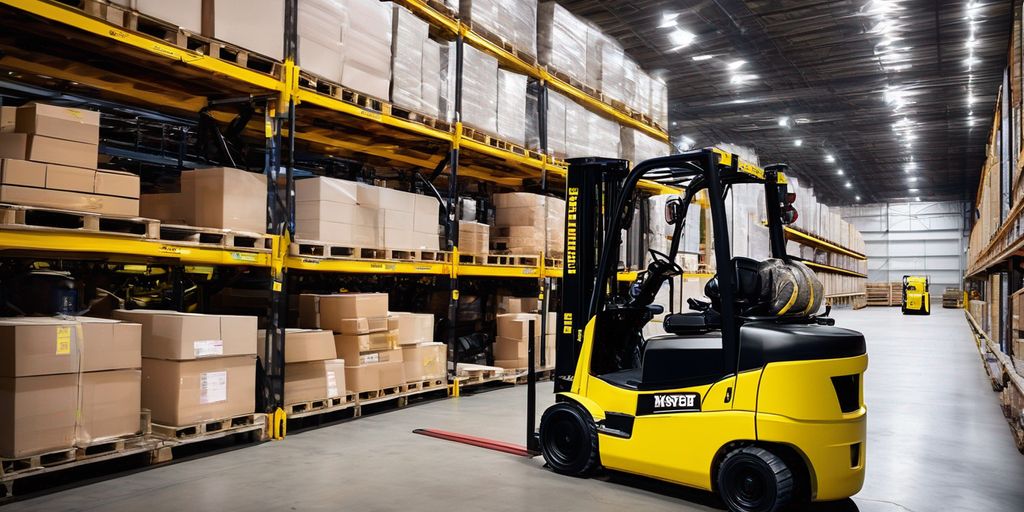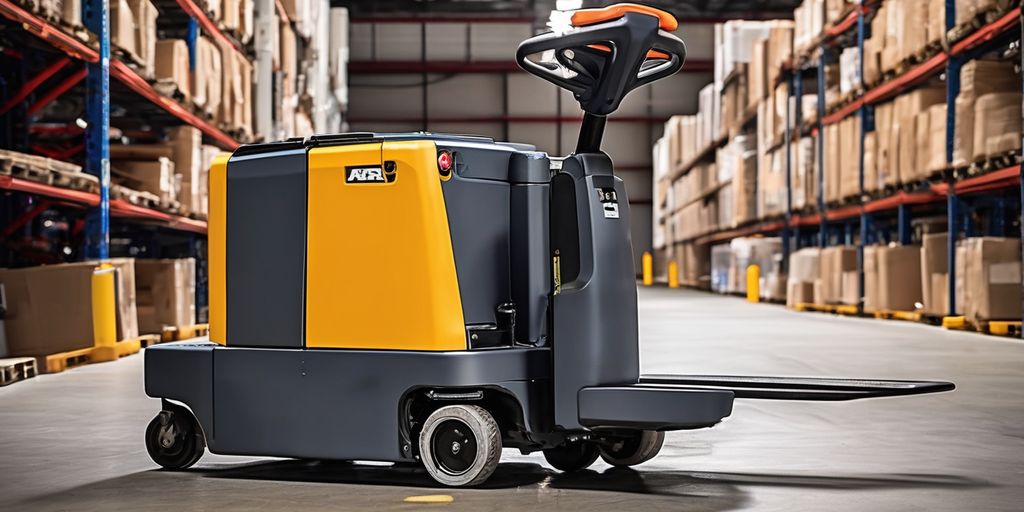Purchasing a new forklift is a significant investment that can greatly impact your business's efficiency and productivity. Whether you're a first-time buyer or looking to upgrade your existing equipment, understanding the various types of forklifts, key features, and other essential factors is crucial. This ultimate guide will walk you through everything you need to know to make an informed decision.
Key Takeaways
- Understand the different types of forklifts available, such as electric, internal combustion, and warehouse forklifts, to determine which best suits your needs.
- Evaluate key features like load capacity, lift height, and fuel type to ensure the forklift meets your operational requirements.
- Consider your specific operational needs, including indoor vs. outdoor use, frequency of use, and job-specific requirements.
- The importance of dealer support and service cannot be overstated; look for good warranty options, availability of spare parts, and a reputable dealer.
- Explore financing options like leasing, loans, and budget planning to make the investment more manageable.
Understanding Different Types of Forklifts
When it comes to buying a new forklift, understanding the distinct characteristics of each type is crucial for making the best decision for your specific needs. The type of forklift you should purchase will heavily depend on its intended use and the environment where it will be used.
Key Features to Look for in a New Forklift
When purchasing a new forklift, it's essential to consider several key features to ensure you select the best equipment for your needs. Understanding these features can significantly impact your operational efficiency and safety.
Evaluating Your Operational Needs
Indoor vs Outdoor Use
When deciding on a forklift, it's crucial to determine whether it will be used primarily indoors or outdoors. Indoor environments, such as warehouses, often require forklifts with specific features like non-marking tires and lower emissions. On the other hand, outdoor environments may necessitate forklifts with more rugged tires and higher durability to withstand various weather conditions.
Frequency of Use
Understanding how often the forklift will be in operation is essential. How many hours will the forklift machine be in use per day? This will help you decide on the type of forklift that can handle the workload without frequent breakdowns. For instance, electric forklifts are ideal for light to moderate use, while internal combustion forklifts are better suited for heavy-duty operations.
Specific Job Requirements
Consider the specific tasks the forklift will perform. Will it need to lift heavy loads to significant heights, or will it operate in tight spaces? What environment are you operating in — cold room, warehouse, construction, etc.? Additionally, think about any specific accessories or attachments that might be required to complete the job efficiently.
Evaluating your operational needs thoroughly ensures that you choose a forklift that not only meets your current demands but also future-proofs your operations.
The Importance of Dealer Support and Service

When purchasing a new forklift, understanding the essential parts of dealer support and service is crucial for long-term satisfaction and operational efficiency. A reliable dealer can provide invaluable assistance, from sourcing the right equipment to ensuring it remains in optimal condition throughout its lifecycle.
Financing Options for Your New Forklift
Leasing vs Buying
When deciding between leasing and buying a forklift, it's essential to consider your operational needs and financial situation. Leasing can be a cost-effective solution, especially for businesses that need the latest models without a large capital investment. On the other hand, buying a forklift outright means you own the asset, which can be beneficial for long-term use.
Loan Options
Financing the purchase of a forklift through a loan is another viable option. Most forklift purchases are financed over a 36 or 60-month term, often with equal monthly payments. Depending on your negotiation, a finance term can also be as short as 12 months or up to 72 months. Payments depend on the equipment’s purchase price, the customer’s budget, and credit rating.
Budget Planning
Effective budget planning is crucial when considering a new forklift. It's important to account for not just the purchase price but also ongoing costs such as maintenance, insurance, and potential downtime. Consider used forklifts, training, common repairs, and maintenance impact for cost-effective solutions.
Selecting the right forklift financing is as important as choosing the right equipment. Make sure to evaluate all options carefully to find the best fit for your business needs.
Safety Considerations When Buying a New Forklift
When purchasing a new forklift, safety should be a top priority. Ensuring that the forklift meets all safety standards and regulations can prevent accidents and injuries in the workplace. Below are some key safety considerations to keep in mind.
Safety Features
Modern forklifts come equipped with various safety features designed to protect both the operator and the surrounding workers. Look for forklifts that include features such as stability control, automatic braking systems, and ergonomic designs. These features can significantly reduce the risk of accidents and improve overall operational safety.
Operator Training
Proper training for forklift operators is crucial for maintaining a safe working environment. Ensure that all operators are certified and have undergone comprehensive training programs. This includes understanding the forklift's controls, load capacity, and safe operating procedures. Regular refresher courses can also help keep safety practices up to date.
Regulatory Compliance
Forklifts must comply with various safety regulations and standards. Make sure the forklift you purchase meets all local and national safety requirements. This includes adhering to guidelines set by organizations such as OSHA (Occupational Safety and Health Administration) and ANSI (American National Standards Institute). Compliance not only ensures safety but also helps avoid legal issues and fines.
Safety is not just about features and compliance; it's about creating a culture of awareness and responsibility among all employees.
By focusing on these safety considerations, you can make a well-informed decision and choose a forklift that will contribute to a safer and more efficient workplace.
Where to Buy a New Forklift
When it comes to purchasing a new forklift, there are several avenues you can explore to find the best option for your needs. Understanding where to buy can significantly impact your overall satisfaction and the total cost of ownership.
Conclusion
Purchasing a new forklift is a significant investment that requires careful consideration and thorough research. By understanding the various factors involved, such as the type of forklift, fuel options, load capacity, and whether to buy new or used, you can make an informed decision that best suits your business needs. This guide has provided you with essential insights into the forklift buying process, from the basics to the finer details. Remember, the right forklift can enhance your operational efficiency and productivity, making it a valuable asset to your business. Take the time to evaluate your options and choose wisely to ensure a successful purchase.
Frequently Asked Questions
What are the key differences between buying a car and a forklift?
While both are significant investments, buying a forklift involves considerations such as load capacity, lift height, and fuel type, which are not relevant when purchasing a car. Additionally, forklifts are often used in industrial settings, making dealer support and service crucial.
Should I buy a new or used forklift?
The decision depends on your budget and operational needs. New forklifts come with the latest features and warranties, while used forklifts are more affordable but may require more maintenance.
What can go wrong when buying a forklift?
Common pitfalls include not assessing your operational needs accurately, overlooking the importance of dealer support, and failing to consider long-term maintenance costs. It's essential to do thorough research and possibly consult with an expert before making a purchase.
What are the benefits of buying a new forklift?
New forklifts offer the latest technology, better energy efficiency, and come with warranties. They also tend to have lower maintenance costs initially and can be more reliable than used models.
What should I inspect before buying a used forklift?
Before purchasing a used forklift, inspect the condition of the mast, forks, and lift chains. Check the engine or motor, tires, and hydraulic system. Additionally, review the maintenance history and ensure there are no major repairs needed.
What are the financing options available for buying a forklift?
You can either lease or buy a forklift. Leasing often requires lower upfront costs and includes maintenance services, while buying involves higher initial costs but gives you ownership of the equipment. Loan options are also available to finance your purchase.




Leave a comment
This site is protected by hCaptcha and the hCaptcha Privacy Policy and Terms of Service apply.